Lost Box, or Lost Zone Toolbox as it was sometimes called, is a deck featuring the Lost Zone engine (Comfey and Colress’s Experiment), and various attackers (usually, but not exclusively, Basic Pokémon), usually (though again, not exclusively) powered up by Mirage Gate. If that description sounds vague, that’s because it is. Lost Box is less a single deck than an agglomerate of various overlapping archetypes that have existed ever since the release of Lost Origin, more than a year ago.
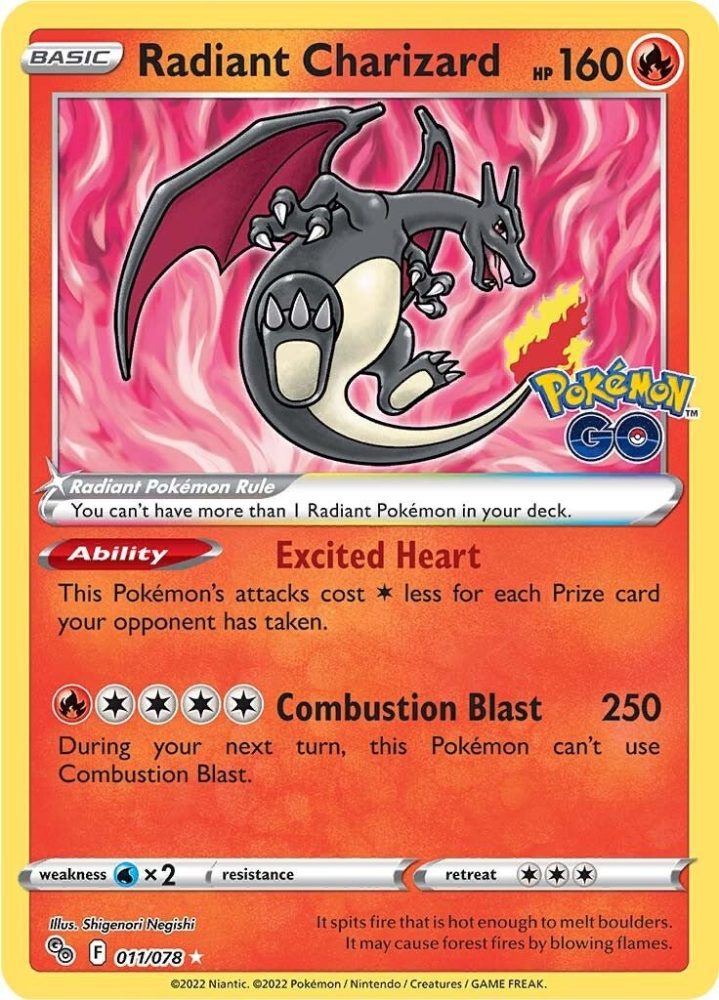
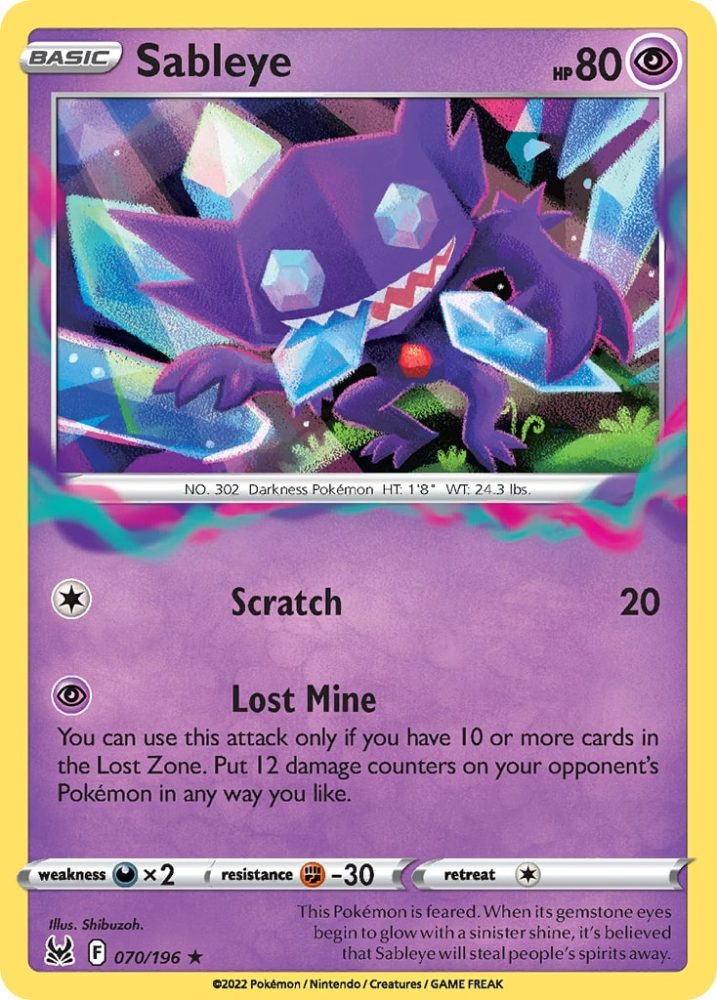
Establishing a complete taxonomy of Lost Box decks would be fastidious and outside the scope of this article, but to keep it simple, they can generally be divided into two main branches, depending on which Radiant Pokémon they use. The first branch includes decks using Radiant Charizard. These decks usually rely on Cramorant as their early attacker and transition quickly to using Sableye, then use Radiant Charizard as a late game attacker. We usually refer to these decks as SableZard, and they are typically not very reliant on Mirage Gate; some players even opt not to include any copy of it. SableZard was the more popular Lost Box variant upon Lost Origin’s release, getting second place at the Yokohama Champions League in Japan, then first place at Peoria Regionals as soon as Lost Origin was legal. The deck has obviously changed in the year since then, but not as much as you’d expect; it still plays in a very similar way to its first incarnations.
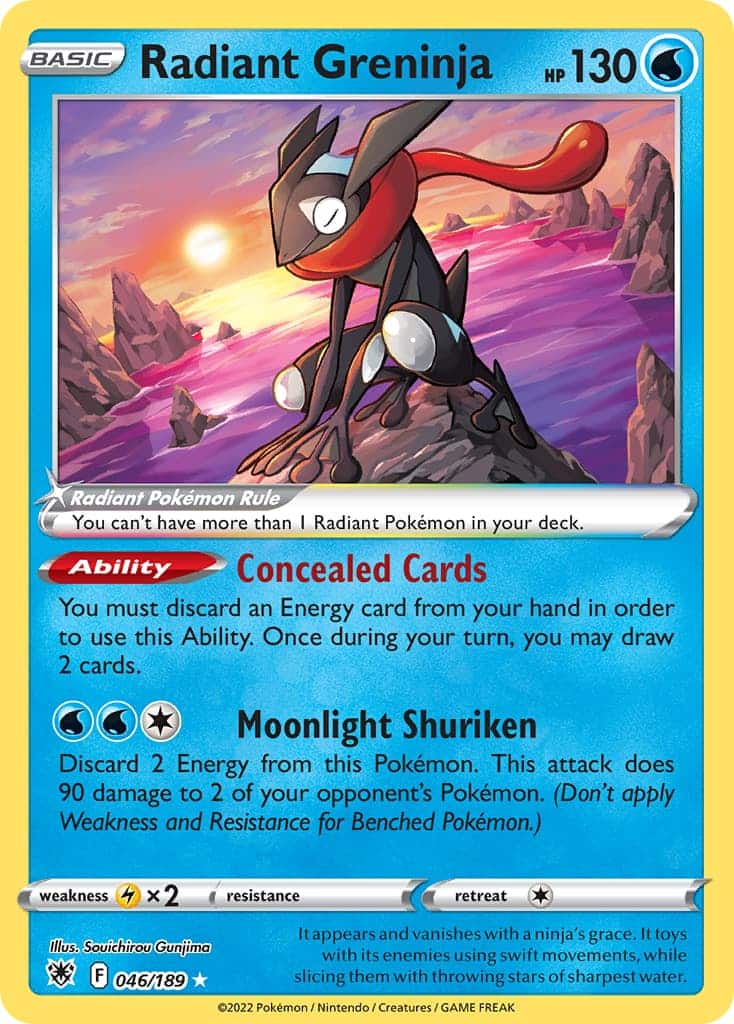
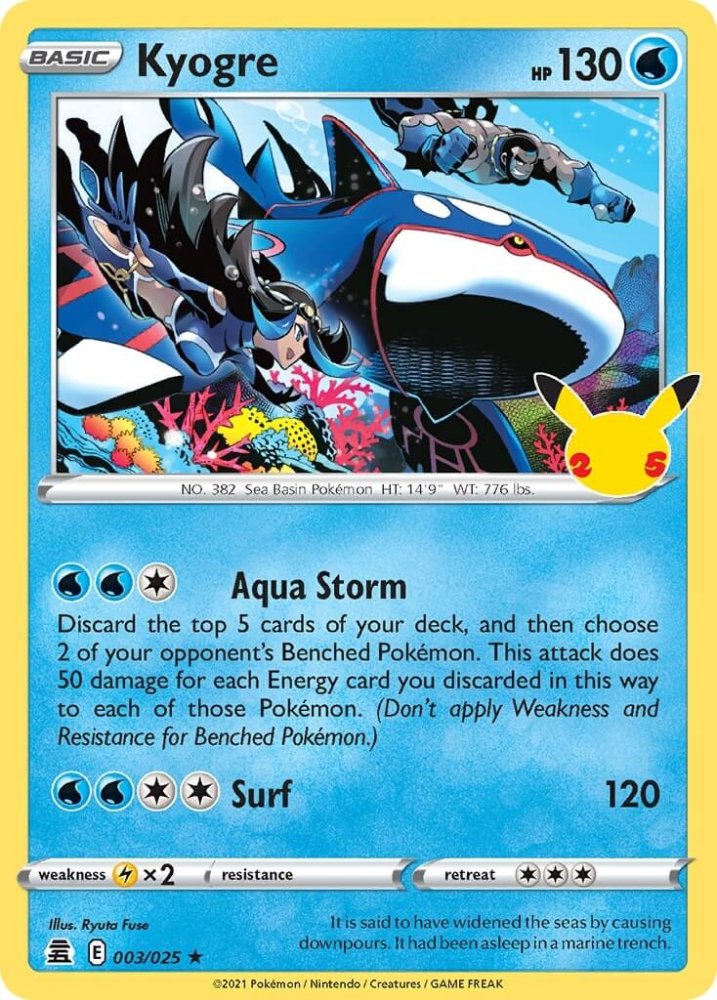
The second branch includes decks using Radiant Greninja, which are extremely varied. These decks usually run three or more types of Basic Energy and a full four copies of Mirage Gate in order to power up various attackers. Apart from Fire Energy, every color of Basic Energy has been used successfully in this type of deck at some point. Notable variants include Kyogre (a variant that aims to take early Prizes, then finish the game with Kyogre CEL’s Aqua Storm after drawing its whole deck and shuffling in Energy back with Energy Recycler), Rayquaza (a variant using Rayquaza VIV and Raikou VIV to use powerful attacks, popularized in the Silver Tempest format as a way to deal with Lugia VSTAR), and Turbo Lost Box (the main variant after rotation, using Dragonite V, Raikou V, Forest Seal Stone and up to four copies of Lost Vacuum to use Mirage Gate as early as the first turn).
Note that I exclude from this list decks that are focused on one main attacker, like Giratina VSTAR and Hisuian Goodra VSTAR; these decks are usually considered to be their own archetypes, outside of the “Lost Box” denomination, although there is, as always, some overlap.
Lost Box has been a dominant force in the metagame ever since the deck came out, but recently, upon Paradox Rift’s release, the deck fell out of favor as new threats were added to the game. Nevertheless, while Lost Box is probably in the worst place it’s ever been, it’s far from dead; like countless top tier archetypes, it never dies out but manages to adapt to overcome these challenges. It’s becoming apparent that a new variant of Lost Box is emerging, relying on a new powerful Basic Pokémon. In this article, I will explain what are Lost Box’s main enemies and how it’s adapting to beat them.
First, let’s consider the facts. Before Paradox Rift came out, Lost Box was a top tier deck, by any metric. Consider the last three major events before Paradox Rift for which we have data from official streams: Sacramento, Lille, and Toronto. Lost Box was the most played deck in Sacramento (14% of the metagame) and Toronto (15%), and the third most played deck in Lille (where it still had a 13% share of the metagame). At all three events, it was the most played deck in day 2, with meta shares of 22% (Sacramento), 20% (Lille), and 19% (Toronto). It’s impressive that it was able to improve its share of the metagame between day 1 and day 2: despite being a well-known and expected deck, it was still so good that players couldn’t counter it efficiently (at least, not without sacrificing other matchups).
However, in the three major events after Paradox Rift (again, using data from the official stream), Lost Box fell hard. At the Latin America International Championships (LAIC) and Gdansk Regionals, it wasn’t among the six most played decks, and only managed to reach fifth place in Stuttgart, with a meta share of 8%. It didn’t fare much better in day 2, being 7% of the day 2 metagame at LAIC and 8% in Stuttgart. It did manage to reach top 8 or more at each events, though, so the deck can still perform, but it has lost a lot of credit in the eyes of most players. How did this come to be?
Paradox Rift has been a very impactful set for the competitive metagame, and many of its best new cards hurt Lost Box in a way or another. Here are three:
- Iron Hands ex, the boogeyman of the format, is a huge threat to decks relying on low HP Pokémon, like Lost Box’s Sableye, Cramorant and Comfey. It can take multiple Prizes with Amp You Very Much, so one of Lost Box’s best attributes, its reliance on one-Prizers, is negated. Iron Hands ex is a staple in Miraidon ex and Chien-Pao ex / Baxcalibur, and if it can attack early enough and the Lost Box player has no answer, it can run away with the game.
- Similarly, Iron Valiant ex can deal considerable damage to a board full of low HP Pokémon, using Tachyon Bits to KO them without attacking. Iron Valiant ex / Entei V has proved to be better than most people anticipated, getting second place at LAIC, and that can make players hesitate to play a deck like Lost Box.
- It’s not only new decks that can beat Lost Box. The new Jirachi is a perfect counter to Sableye and can be run by many decks, notably Gardevoir ex, to improve their Lost Box matchup. This matchup was always slightly in Lost Box’s favor, but now, Gardevoir can protect its Pokémon, even its damaged Pokémon, from both Radiant Greninja and Sableye with Manaphy and Jirachi. This changes the matchup significantly. Jirachi can also be played in Giratina VSTAR, Charizard ex, etc., so Lost Box needs to find new ways to deal with these matchups.
In addition to these issues, Rapid Strike Urshifu VMAX / Inteleon VMAX has been seeing more use recently, being strong against many of the new metagame’s best decks and getting some new cards to use. This is one of Lost Box’s worst matchups, which doesn’t help its chances.
A Paradoxical Adaptation
Now, I want to cover how Lost Box is adapting to deal with the threats I just mentioned.
First of all, I should address an objection you may be thinking of. “What adaptation? SableZard just won Stuttgart Regionals, and you said yourself that the deck has barely changed in a year!” This is true. SableZard does its own thing. It has its own way of dealing with problematic matchups (for example, Technical Machine: Devolution for Charizard ex), and its own issues to consider (like Lost City). There’s a lot to be said about the deck’s strengths and weaknesses, but I think that it’s a bit outside of the scope of this article. The short version is: yes, SableZard is good, although that depends on some factors, like Jirachi’s popularity and which variant of Mew VMAX sees more play (Fusion Mew deals with Spiritomb more easily and usually runs Lost City, so it’s a bit more dangerous). It should be mentioned that the deck doesn’t have an answer to everything: its Rapid Strike matchup, for example, is very bad, and SableZard just hopes to dodge it rather than tech for it.
That being said, the focus of this article is mostly on Radiant Greninja variants. How are they evolving?
First of all, every Lost Box deck needs an answer to Iron Hands ex. If a Miraidon player manages to use Amp You Very Much twice, the game is pretty much over, so Lost Box needs to be able to KO it back after it attacks. That’s not as easy as it sounds. Iron Hands ex frequently has a Bravery Charm attached, so the Lost Box player needs to either find a Lost Vacuum or have an attacker that can KO a 280 HP Pokémon, which excludes Dragonite V and various Fighting-type Pokémon. There’s an universal solution, though: Roaring Moon ex. With Frenzied Gouging, this Pokémon can deal with Iron Hands ex, and plenty of other dangerous Pokémon, like Rapid Strike Urshifu VMAX. Its Dark type also makes it useful against Mew VMAX and Gardevoir ex.
The other main problem to solve is how to deal with decks running Manaphy and Jirachi, such as Gardevoir. If you can’t take KOs on the Bench, how can you deal with a stream of one-Prize attackers? The answer is Iron Hands ex itself! Since Iron Hands is such a threat to Gardevoir and other one-Prize attackers, why not use it in Lost Box? We may not be able to KO vulnerable Benched Pokémon, but if we can KO the Active Pokémon for multiple Prizes, we can take the lead! For the same reason, it’s also a powerful weapon in the mirror match. By the way, Iron Hands ex’s Arm Press can also OHKO Inteleon VMAX!
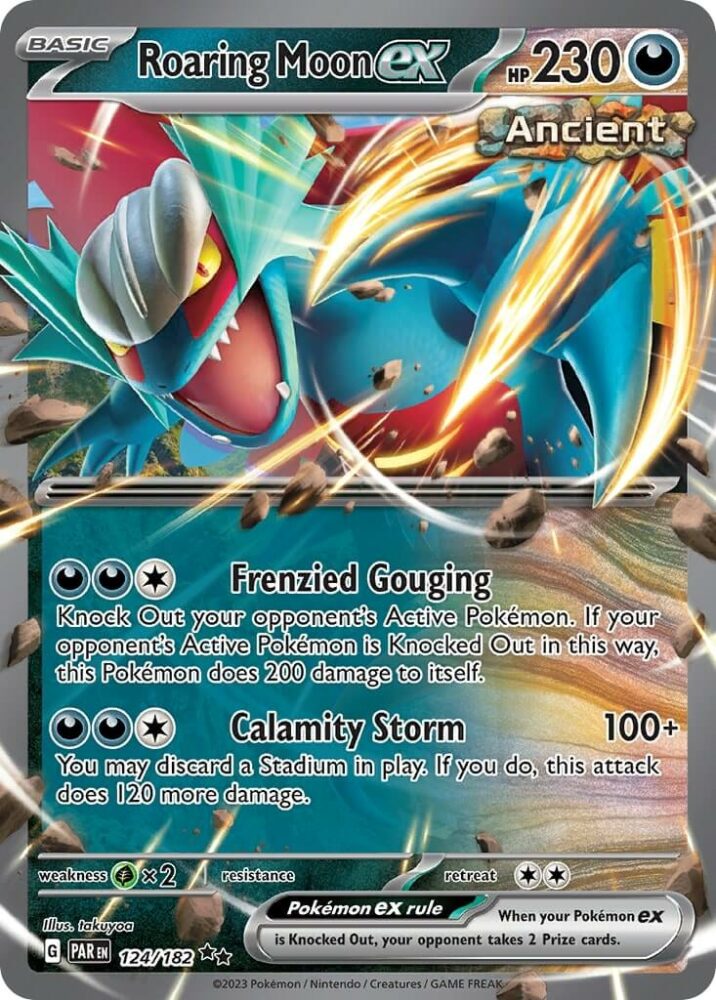
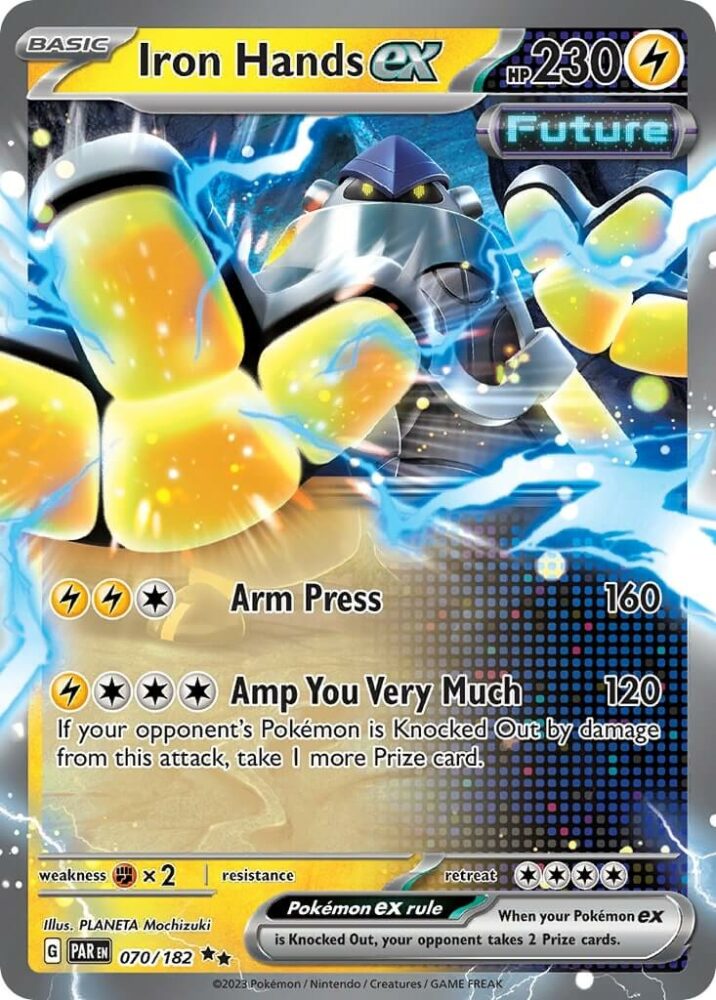
The combination of Roaring Moon ex and Iron Hands ex allows Lost Box to deal with every kind of Pokémon. It was first used at LAIC by Adam Hawkins, who already pioneered Lost Box Rayquaza one year before, at the previous LAIC! A more complicated variant of this idea was then used at Gdansk Regionals by Tord Reklev who made the top 8 with it. More players are now picking up on it, one of them being Kristian Hodas who made top 4 at Stuttgart Regionals with it. Note that there’s no consensus on the decklist yet: every player is adding their own cards to the mix, using different types of Energy, cutting different cards to find the space they need. I’m sure that more refined lists will emerge soon, as players decide on which Pokémon are worth including after all. Nevertheless, in the meantime, this core of Roaring Moon ex and Iron Hands ex seems to be the combination on which everyone agrees. LimitlessTCG has picked up on this new trend and already started categorizing this new variant as “Lost Box Paradox”; my plea to the world, and to you, dear reader, is to please call it Lost Parabox instead. It’s funnier.
Building the deck
Here are some cards: Palkia VSTAR. Raikou V. Giratina VSTAR. Minior. Galarian Moltres V. Dragonite V. Kyogre. Tropius. Mew ex. Gift Energy. Super-Effective Glasses. What do they have in common?
If you guessed “they’ve all been played in Lost Box”, you only get partial credit! The actual answer is: they’ve all been played in Lost Parabox, as in, that specific variant I’m discussing that has only existed for three events, and been used by about six players. That’s how much variation there is to the deck, right now. Look at Adam Hawkins’s deck from LAIC, at Tord Reklev’s from Gdansk, at Kristian Hodas’s from Stuttgart: they’re building very different decks around the same core. The latter wasn’t even playing Sableye, a card that was core to all Lost Box decks until now! As good as Sableye is, the decks that are the weakest to it can now counter it effectively with Jirachi. Players are recognizing that Iron Hands ex is currently a better way to deal with these kinds of decks.
Let’s discuss some of these ideas and how and why they work.
- Kyogre: Kyogre is not a card you can simply fit in any Lost Zone deck. You need to include Energy Recycler alongside your Super Rods, at least eleven Basic Energy, and play PokéStop to dig further into your deck. That being said, I think it’s worth playing. Kyogre’s strength is dealing with boards of high HP Pokémon, notably against Iron Valiant ex / Entei V, one of Lost Box’s enemies. It can also work against plenty of other decks. For example, if a Miraidon player makes the mistake of filling their Bench without playing down an Iron Hands ex (unlikely, but it can happen with an awkward opening hand), you can afford to draw through your deck without attacking while your opponent takes three Prizes. Then, use Iron Hands ex or Roaring Moon ex to take two Prizes; the Miraidon player can draw two more Prizes on their turn, and you should be able to finish the game with Kyogre on the next turn. (You can also use Kyogre even if they do use Iron Hands ex, but the timing is harder; you’ll need to deal with Iron Hands ex first.) Kyogre is also a win condition against Mew VMAX, and can be used against various minor decks like Roaring Moon ex.
- Super-Effective Glasses package: Kristian Hodas, Miloslav Posledni and Pedro Eugenio Torres all played Super-Effective Glasses in Lost Box in Stuttgart. This package includes two copies of Super-Effective Glasses, Town Store, Forest Seal Stone, Minior, and other attackers. Town Store acts as a consistency card in Lost Box, since it can get Forest Seal Stone, which itself can get any other card; then, Lost Vacuum can remove Forest Seal Stone or Town Store from play to add two cards to the Lost Zone. Super-Effective Glasses + Minior is a strong tech against both Snorlax Stall and Iron Hands ex. (Iron Hands ex with Bravery Charm can tank a hit from Minior, which is why Lost Vacuum needs to be played alongside this package.) Unlike other solutions like Roaring Moon ex, Minior can deal with Iron Hands ex without needing a Mirage Gate, so you don’t need to get to seven cards in the Lost Zone before dealing with Iron Hands ex.Super-Effective Glasses can also help dealing triple damage against other Pokémon. Here are some examples: Iron Hands ex can use Amp You Very Much to take four Prizes against Inteleon VMAX, or three against Palkia VSTAR. Tropius can deal 360 damage to Charizard ex. Mew ex can copy Rapid Strike Urshifu VMAX’s G-Max Rapid Flow to deal 360 damage to it and 120 damage to Octillery.This package should give a Lost Parabox player an advantage in the mirror match, since they can both use Iron Hands ex and counter the opponent’s Iron Hands ex more easily than other variants.
- Gift Energy: One interesting card in Kristian Hodas’s decklist is Gift Energy. This new Lost Box variant can take Prizes pretty quickly by attacking with Iron Hands ex, but that can put them at risk of getting hit with Iono or Roxanne. By putting Gift Energy on Iron Hands ex, the Lost Parabox player becomes protected against these cards. Since the opponent can’t let Iron Hands attack multiple turns in a row, they’ll need to KO it, and be forced to activate Gift Energy. Note that some decks can avoid triggering the effect by taking a KO without dealing damage, with Giratina VSTAR’s Star Requiem or Roaring Moon ex’s Frenzied Gouging.
My decklist
In my opinion, there are plenty of good ideas to pick from other players who have used Lost Parabox, but I think that running plenty of techs will become less effective as this variant becomes more widespread and expected, losing the element of surprise. I believe that the deck will become better (although, of course, some techs may be worth running depending on metagame shifts) by getting simplified. Also, as mentioned above, I think Kyogre is a strong addition to the Lost Parabox build.
(If you skipped the rest of the article to get to the decklist, this may not make a lot of sense; you should scroll up and read it!)
Here’s my current decklist, inspired by a list used online by Japanese player tomo1713:
| Pokemon | Trainers | Energy |
|---|---|---|
| 4 Comfey LOR 79 | 4 Colress’s Experiment LOR 155 | 4 Darkness Energy |
| 1 Radiant Greninja ASR 46 | 1 Boss’s Orders PAL 172 | 4 Water Energy |
| 1 Cramorant LOR 50 | 1 Raihan EVS 152 | 3 Lightning Energy |
| 1 Iron Hands ex PAR 70 | 1 Roxanne ASR 150 | |
| 1 Roaring Moon ex PAR 124 | 4 Switch Cart ASR 154 | |
| 1 Kyogre CEL 3 | 4 Escape Rope BST 125 | |
| 4 Battle VIP Pass FST 225 | ||
| 4 Mirage Gate LOR 163 | ||
| 4 Nest Ball SVI 181 | ||
| 3 Super Rod PAL 188 | ||
| 2 Pokégear 3.0 SVI 186 | ||
| 2 Energy Recycler BST 124 | ||
| 1 Counter Catcher PAR 160 | ||
| 1 Canceling Cologne ASR 136 | ||
| 1 Hisuian Heavy Ball ASR 146 | ||
| 1 Pal Pad SVI 182 | ||
| 2 PokéStop PGO 68 |
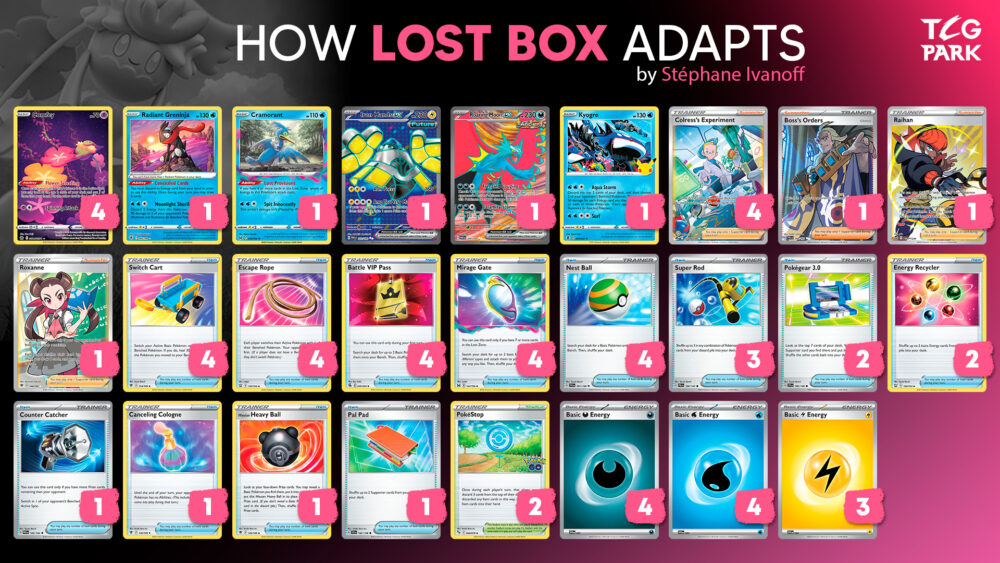
Instead of trying to fit plenty of techs, this list focuses on the essentials. I think consistency is important, so I value cards like Pokégear and the fourth Nest Ball over some cooler but less reliable additions. I also want to explain a few things:
First of all, even though it’s a Kyogre deck, this list runs Boss’s Orders and Counter Catcher. In the past, Kyogre decks would generally not run Gust effects because they didn’t need to: in matchups where they used Kyogre, they could simply take two Prizes early on and then finish the game with Aqua Storm; against decks using Manaphy, they would use Cramorant and Sableye to win the Prize race. Now that the deck doesn’t run Sableye anymore (which, in turn, is because it’s not as good as before, due to Jirachi), it can’t attack the Bench as reliably, so Boss’s Orders and Counter Catcher are necessary to KO vulnerable Pokémon, ideally with Iron Hands ex.
I’m also including Cancelling Cologne, as an additional way of threatening decks like Gardevoir with double-Prize turns: bring Manaphy Active, use Cancelling Cologne, and Moonlight Shuriken (or Aqua Storm!) for multiple Prizes. This may be too unreliable to work, especially given how many Iono Gardevoir plays, so Cancelling Cologne might be cut for something else (or I might add a second Counter Catcher to make this play more likely).
In addition to Colress’s Experiment and Boss’s Orders, I also included Raihan and Roxanne. Raihan is very strong in combination with Iron Hands ex. Without it, you need two Mirage Gate to power up the Lightning-type behemoth in one turn, which may be worth it, but is still a notable commitment. (If possible, I recommend attaching an Energy in advance to Iron Hands ex so you only need one Mirage Gate. For example, in the Gardevoir matchup, if you go first and have a good hand, you can bench Iron Hands ex and attach an Energy to it, then on turn 2 play another Energy and a Mirage Gate to KO your opponent’s Active Pokémon.) Raihan can also make Counter Catcher + Cancelling Cologne plays easier.
As for Roxanne, it’s a good card in the mirror match and against other decks that like to accumulate cards in hand, like Giratina VSTAR.
Conclusion
When Paradox Rift was released, I believed that Lost Box’s reign was over. However, even though it faces more threats than ever before, it looks like the deck is still good. Even the stats I quoted indicate that, although the deck is played less than ever, it doesn’t actually seem to have a bad day 2 conversion rate. While it’s unlikely that it will reach the same level of popularity as a few months ago, I think that Lost Box could very well reach a state of equilibrium in which it sees regular play, enough to make top 8 at most events without being overwhelming: in other words, the same status that Mew VMAX has achieved.
SableZard is its own beast: its consistency and linearity make it very good, but it’s also vulnerable against some decks, like Rapid Strike. On the other hand, this new Lost Parabox variant (yes, I’m trying to make it a thing) is the heir to all Radiant Greninja variants of Lost Box: it can be teched to deal with anything, but it can’t fit all the techs it would want in sixty cards. I can’t wait to see how the deck evolves, and whether other decks try to counter it, or if it can stay under the radar for a little bit longer. I wouldn’t be surprised to see some top tier players running it at upcoming Regionals, though!